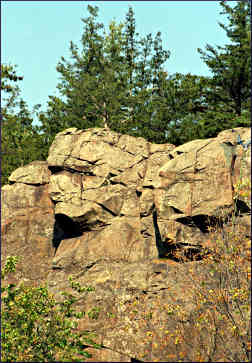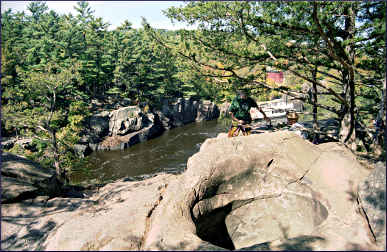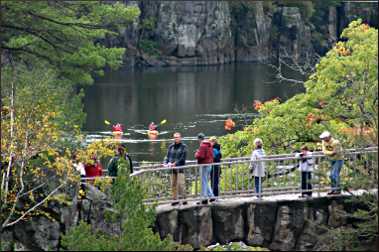Sightseeing on the St. Croix
Thanks to glaciers, Taylors Falls is the Pothole Capital of the World.

© Beth Gauper
There's only one place in the Midwest where potholes are a tourist attraction instead of a nuisance.
Standing at the bottom of the 35-foot-deep Bake Oven, touching walls as smooth as vinyl, it's easy to imagine the scene 10,000 years ago, when sheets of water from a melting glacier roared past Taylors Falls, into what now is the St. Croix River Valley.
They came with such fury that whirlpools laced with sand and gravel drilled cylindrical holes into solid rock — potholes, the world's deepest.
On the Minnesota side of the river, that fury must have had apocalyptic proportions. Behind Angle Rock, where the river takes a hard right, there's an otherworldly place of giant slabs and cavities.
Here, so many potholes formed that they merged into what now is called the Devil's Parlor. The Bake Oven, where one pothole bored into another, is nearby, along with the Lily Pond, the Hourglass and the 67-foot Bottomless Pit.
Along the river, the waters tore away everything but the hardest volcanic rock. Its vagaries nudged relentlessly at softer rock, leaving formations that have long fascinated tourists, especially the craggy Old Man of the Dalles.
Named Dalles of the St. Croix — dalle is French for rocky slab — this gorge is a first cousin of the Wisconsin Dells, where meltwater sculpted riverside formations out of softer sandstone.
The St. Croix dalles occupy a shorter stretch of river, but the captains of the paddlewheelers who have been showing it to tourists since 1904 have plenty to point out: The Lion's Head and the Elephant's Head. The Turk with a turban.
And there's the Holy Cross, for which French fur-traders named the river. From a different angle, it turns into a face that the loggers called the Old Egyptian.

© Beth Gauper
These Dalles, however, occupy a much more picturesque valley. Minnesota's Interstate State Park preserves the western shore, and Wisconsin's Interstate State Park preserves it on the east; together, they're called "Gift of the Glaciers."
Everyone comes here: Hikers, to walk along the high bluffs. Rock-climbers, to rappel down the hairline of the Old Man. Children, to gambol like mountain goats among the fantastic formations. Canoeists, to paddle down the river.
And sightseers come in crowds to look at fall colors and browse in the shops of Taylors Falls' tiny downtown.
There's always been plenty of traffic around Taylors Falls.
In the 1840s, lumbermen from Maine streamed into the St. Croix Valley to launch the nation's next timber boom. It arrived with a vengeance.
In 1886, three miles of logs, enough to build 20,000 three-bedroom houses, created the world's largest logjam around Angle Rock; it took 200 loggers six weeks to clear.
Settlers followed in the 1850s, among them groups of Swedes who walked from Taylors Falls' steamboat landing into Chisago County, giving it the largest concentration of Swedes outside Sweden.
Swedes still are coming to Taylors Falls, now as tourists: The area was featured in "The Emigrants" and three other historical novels written by Swedish author Vilhelm Moberg, who spent the summer of 1948 in Chisago City while researching pioneer letters and diaries.
It was the Yankees, however, who first got a foothold in Taylors Falls. W.H.C. Folsom came to Prairie du Chien on the Mississippi in 1836 at age 19, having spent $200 to buy independence from his father in Maine.
He worked his way up to Taylors Falls, prospered in the lumber and mercantile businesses and, in 1855, built a Greek Revival house on the hill overlooking the town and valley.
It and its furnishings stayed in the family until it was bought, restored and opened for tours by the Minnesota Historical Society.
The Folsom House is the largest of a collection of Federal and Greek Revival homes, all white with green shutters, that sit in a park-like setting that immigrant workers sarcastically dubbed "Angel Hill."
Visitors still can see the dent in the plank floor from Mary Jane Folsom's heel where she worked the pedal of the piano Bill shipped in from St. Louis.

© Beth Gauper
They see a favorite cabinet, finished with buttermilk and blueberry juice, and one of Mary Jane's hoop skirts, worn by a mannequin.
It's a vestige of a steamboat era that hardly seems gone in Taylors Falls.
Trip Tips: Taylors Falls, Minnesota
When to go : It's fun year-round, but many people like to go in autumn.
For more about travel along the river, see Autumn along the St. Croix.
For more about Wisconsin Interstate State Park and the Ice Age Trail, see Trail mix in St. Croix Falls.
Paddlewheeler cruises : Excursions are offered daily from the first weekend in May through mid-October.
Minnesota Interstate Park : A quarter mile of the Angle Rock and half-mile of the Picnic Area Loop trails are disabled-accessible.
Canoe and kayak rentals : Wild Mountain provides boats and shuttles from Minnesota's Interstate Park to Osceola, Wis., or William O'Brien State Park in Marine on St. Croix. Reservations are recommended.
Wisconsin Interstate Park : This park's trails have the best view of the river valley; don't miss the Pothole Trail. The 1,100-mile Ice Age National Scenic Trail starts here and the Ice Age Interpretive Center is worth a visit.

© Beth Gauper
Many naturalist programs are given, and there's skiing in winter. A daily vehicle permit is $8 Wisconsin residents, $11 non-residents. Hikers can reach its trails on foot from Taylors Falls.
Franconia Sculpture Park : It's fun to wander around this collection of outdoor sculptures, at the junction of Minnesota 95 and U.S. 8, three miles west of Taylors Falls.
Wild River State Park : The park is a favorite of cross-country skiers, with 35 miles of groomed trails. A candlelight ski and snowshoe hikes are held annually.
Skis can be rented at the Trail Center, which has a fireplace and snack bar. There's also a guesthouse and two camper cabins to rent. For more, see Snug on the St. Croix.
Wild Mountain : Seven miles north of Taylors Falls, this usually is the first alpine ski area in Minnesota to open for the winter. In summer, it's a water park with alpine slides and go-karts.
Folsom House : Guided tours are given Wednesday-Monday afternoons from Memorial Day weekend through mid-October, $6 adults, $4 children 6-12.
Accommodations : Old Jail B&B, in an 1869 saloon and an 1884 jail on a hill at the edge of downtown, has three suites and a cottage.
Dining : For homemade root beer, floats and burgers served by carhops in poodle skirts, try the Drive-In Restaurant down the street.
Information : Taylors Falls-St. Croix Falls tourism, 715-483-3580.